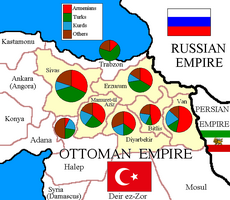Six Vilayets
have been Armenian

The Six vilayets or Six provinces (Template:Lang-ota Vilâyat-ı Sitte) or the Six Armenian vilayets (Template:Lang-hy Vets' haykakan vilayet'ner, Template:Lang-tr[1]) were the Armenian-populated vilayets (provinces) of the Ottoman Empire:
The term
The term Six Armenian provinces was first used in the Congress of Berlin in 1878.[citation needed]
Population
Ethnic groups


- Armenian Patriarch of Constantinople, 1912
- [2]
| Ethnic groups | Bitlis | Diyarbekir | Erzurum | Mamuretülaziz | Sivas | Van | TOTAL | % |
| Armenians | 180,000 | 105,000 | 215,000 | 168,000 | 165,000 | 185,000 | 1,018,000 | 38.9 |
| Turks1 | 48,000 | 72,000 | 265,000 | 182,000 | 192,000 | 47,000 | 806,000 | 30.8 |
| Kurds2 | 77,000 | 55,000 | 75,000 | 95,000 | 50,00 | 72,000 | 499,000 | 19.1 |
| Others3 | 30,000 | 64,000 | 48,000 | 5,000 | 100,000 | 43,000 | 290,000 | 11.1 |
| TOTAL | 382,000 | 296,000 | 630,000 | 450,000 | 507,000 | 350,000 | 2,615,000 | 100 |
|
1 including Qizilbash | ||||||||
- Ottoman official population statistics, 1914
- [3]
Note: The Ottoman population statistics doesn't give information for separate Muslim ethnic groups such as the Turks, Kurds, Circassians, etc.
Most modern Western scholars agree that the official Ottoman population statistics of 1914 that were based on an earlier census underestimated the number of ethnic minorities, including the number of Armenians.[4] The Ottoman figures didn't define any ethnic groups, only religious ones. So Armenian meant an adherent of Armenian Apostolic Church. Ethnic Armenians who claimed to be Muslims were counted as Muslims, Armenian Protestants - like Pontic Greeks, Caucasus Greeks, and Laz - were counted as others.
| Ethnic groups | Bitlis | Diyarbekir | Erzurum | Mamuretülaziz | Sivas | Van | TOTAL | % |
| Muslims | 309,999 | 492,101 | 673,297 | 446,376 | 939,735 | 179,380 | 3,040,888 | 79.6 |
| Armenians | 119,132 | 65,850 | 136,618 | 87,862 | 151,674 | 67,792 | 628,928 | 16.5 |
| Others | 44,348 | 4,020 | 5,797 | 4,047 | 78,173 | 11,969 | 148,354 | 3.9 |
| TOTAL | 473,479 | 561,971 | 815,712 | 538,285 | 1,169,582 | 259,141 | 3,818,170 | 100 |
- Maps
-
1893-96, Armenian population
-
Armenian population in the Six vilayets.
Largest cities
All figures are as of early 20th century.
| City | Vilayet | Population | Armenians | % |
|---|---|---|---|---|
| Van[5] | Van Vilayet | 40,000 | 25,000 | 62.5% |
| Sivas[6] | Sivas Vilayet | 60,000 | 30,000 | 50% |
| Erzurum[7] | Erzurum Vilayet | 60,000 | 15,000 | 25% |
| Mezereh[8] | Vilayet of Mamuret-ul-Aziz | 12,200 | 6,080 | 49.8% |
| Bitlis[6] | Bitlis Vilayet | 30,000 | 7,000 | 23% |
| Diyarbakır | Diyarbekir Vilayet | |||
| Arapgir[9] | Vilayet of Mamuret-ul-Aziz | 20,000 | 10,000 | 50% |
| Malatya[10] | Vilayet of Mamuret-ul-Aziz | 40,000 | 20,000 | 50% |
See also
References
- Notes
- ^ Template:Tr icon İsmail Soysal, Türkiye'nin Siyasal Andlaşmaları, I. Cilt (1920-1945), Türk Tarih Kurumu, 1983, p. 14.
- ^ "The Treatment of Armenians in the Ottoman Empire 1915-1916" by JAMES VISCOUNT BRYCE, London, T. Fisher Unwin Ltd., 1916
- ^ "1914 Population Statistics" (PDF). Turkish General Staff. pp. 603–628. Retrieved 29 January 2011.
- ^ Steven T. Katz,The Holocaust in Historical Context, 1994, p. 86 ...indicates (based on 1919 British estimates) that though Ottoman data were generally reliable they did underestimate the Armenian population in 1914...
- ^ Hakobyan 1987, p. 236.
- ^ a b Hakobyan 1987, p. 222.
- ^ Hakobyan 1987, p. 163.
- ^ Hakobyan 1987, p. 134.
- ^ Hakobyan 1987, p. 51.
- ^ Hakobyan 1987, p. 182.
- Bibliography
- Hakobyan, Tadevos (1987). Պատմական Հայաստանի քաղաքները (Cites of historic Armenia) (in Armenian). Yerevan: "Hayastan" Publishing.


